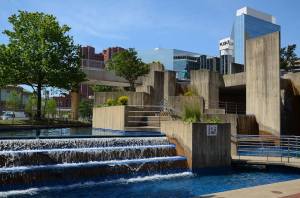Many older pieces of Baltimore’s built environment are well recognized across the country, like the Cathedral, the Bromo Seltzer Tower, and the historic rowhouse fabric. The value of these structures is relatively uncontroversial. The icons of the city’s recent architectural past are less well known. Buildings like the Mies van der Rohe projects at One Charles Center and Highfield House, as well as the work of prolific local modernists like Charles Brickbauer and Alexander Cochran, have been studied by scholars, and are well liked by their owners and users. Another class of historic Baltimore structures, dating from Modernism’s late period, is more famous for being hated. The Brutalist architecture of Baltimore (from the French béton brut, or ‘raw concrete’), is actively disliked. Of the two most well known exemplars of Brutalism in Baltimore, the Morris A. Mechanic Theatre, and the McKeldin Fountain, one is currently undergoing demolition, and the other is under threat. How can preservationists of the recent past engage the public with the value of structures like this, which seem to actively challenge and confront our assumptions about aesthetics, difference, and difficulty? How can architects and historians act as mediators between these buildings and the cities they now find themselves in, to help each make friends with the other.

Recent Comments